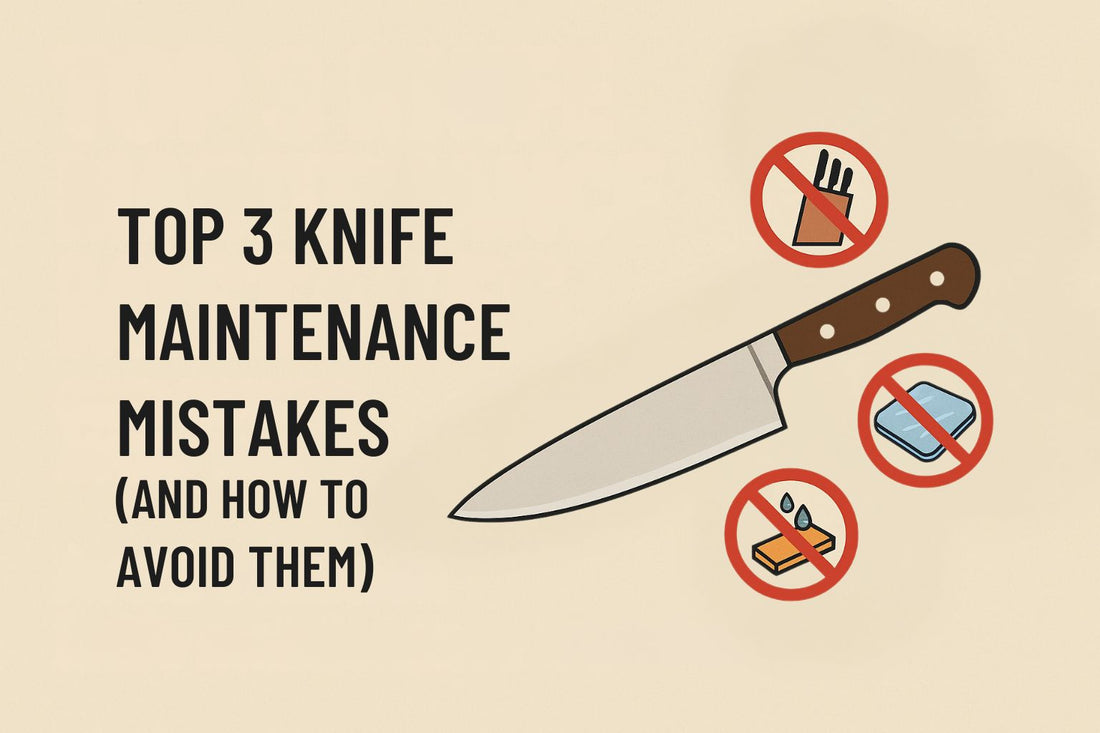
Top 3 Knife Maintenance Mistakes and How to Avoid Them
Share
A well-maintained knife is essential for smooth kitchen operations, whether you’re a home cook or a professional chef. However, many people unknowingly make mistakes that shorten the lifespan of their knives and reduce their efficiency. Proper knife maintenance ensures durability, sharpness, and safe usage. Below, we discuss the top three kitchen knife maintenance mistakes and provide expert tips to avoid them. If your knife has lost its edge, a knife restoration service can help bring it back to life.
1. Improper Knife Storage – The Silent Blade Killer
Many people toss their knives in a drawer with other utensils, causing the blades to become dull and damaged over time. Improper storage can lead to chips, bends, and even safety hazards.
How to Store Your Knife Properly
-
Use a knife block or magnetic strip to keep blades secure and separate.
-
Store knives in individual sheaths if kept in drawers.
-
Avoid stacking knives to prevent blade-to-blade contact.
2. Using the Wrong Cutting Surface – A Fast Way to Dull Your Knife
Chopping on hard surfaces like glass, stone, or metal can quickly wear down your knife’s edge. Many people don’t realize that the wrong cutting board can significantly impact the lifespan of their knife.
Best Cutting Surfaces for Kitchen Knives
-
Use wood or bamboo cutting boards to preserve sharpness.
-
Avoid cutting directly on countertops.
-
Regularly clean and condition wooden boards to prevent bacteria buildup.
3. Neglecting Regular Sharpening – A Dull Knife is a Dangerous Knife
A dull knife requires more force to cut, increasing the risk of slipping and causing injury. Many people wait until their knife is completely dull before sharpening, which makes restoration more difficult.
How to Keep Your Knife Sharp
-
Hone your knife regularly with a honing rod to maintain alignment.
-
Get professional sharpening from Cutting Edge Mobile Knife Sharpening in Concord, California for the best results.
-
Use a whetstone for at-home sharpening, following proper techniques.
Additional Knife Maintenance Mistakes to Avoid
1. Washing Your Knife in the Dishwasher
Dishwashers expose knives to high heat, moisture, and harsh detergents, leading to rust and dullness. Always hand wash and dry immediately.
2. Using Your Knife for the Wrong Tasks
Avoid using kitchen knives to open cans, cut through frozen food, or pry items open, as this can damage the blade.
3. Ignoring Handle Maintenance
Wooden handles can crack if not conditioned, and plastic handles can weaken over time. Keep handles clean and well-maintained.
4. Storing a Wet Knife
Leaving a wet knife in the sink or drying rack can cause rust. Always dry your knife immediately after washing.
5. Skipping Professional Restoration
If your knife is severely damaged, consider a knife restoration service to bring it back to optimal condition.
FAQs
1. How often should I sharpen my kitchen knife for proper maintenance?
It depends on usage, but for proper kitchen knife maintenance, sharpen your knife every 3-6 months and hone it regularly.
2. Can I use a glass cutting board without dulling my knife?
No, glass cutting boards can dull and damage your knife’s edge quickly. Use a wooden or bamboo cutting board instead.
3. Is it okay to wash my knives in the dishwasher?
No, dishwashers expose knives to excessive moisture and heat, causing rust and dullness. Always wash knives by hand.
4. How do I restore a damaged knife?
If your knife has chips, rust, or extreme dullness, a knife restoration service can professionally repair and sharpen it.
5. Where can I get professional knife sharpening in Concord, California?
For expert sharpening and maintenance, reach us at Cutting Edge Mobile Knife Sharpening, Concord, California, (925)-367-3927.
